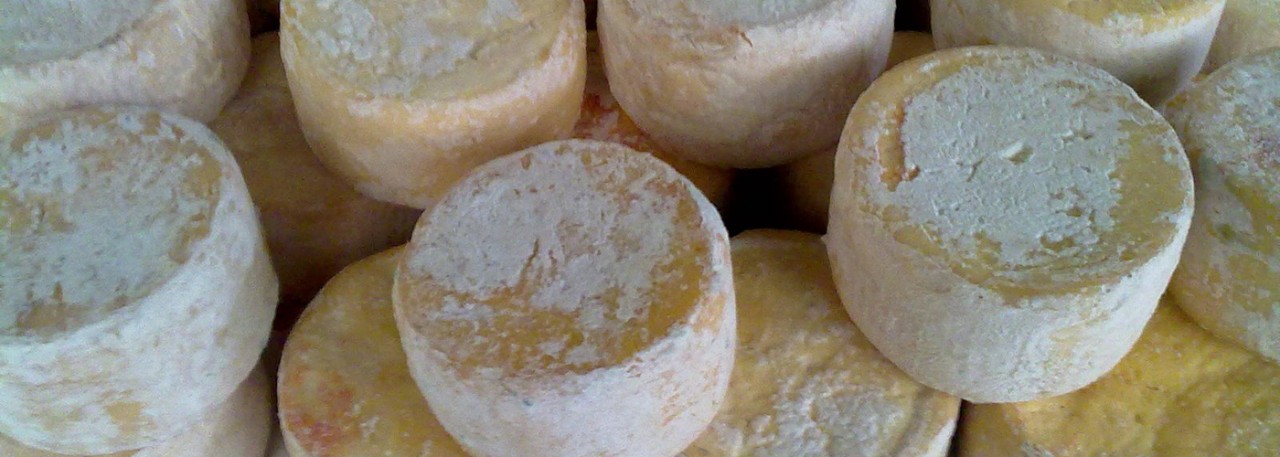.png.transform/rendition-xs/image_image%20(1).png)
Queso Los Beyos PGI
Cheese made from unpasteurized or pasteurized cow, ewe or goat's milk, not mixed together; using lactic acid fermentation and ripened for at least 20 days or 60 days if made from unpasteurized milk.
Tasting notes
Smooth, wrinkled rind, of a color ranging from creamy yellow or pale yellow and light brown, depending on the species from which the milk was obtained: cow, ewe or goat's milk, respectively.
Other notes
Semi-firm to firm paste, close consistency, with absence of holes from the fermentation process and scarce presence of mechanically-produced cracks, crumbly or flaky when cut; white in goat's cheese and ivory or pale yellow in cheese made from ewe and cow's milk.
Firm texture, no elasticity (or very weak) and medium to high flakiness.
Mild smell and aroma, within the lactic family, a stronger smell and aroma in the ewe and goat's cheese that is slightly reminiscent of the species from which they are obtained.
Mild flavor, becoming stronger in the ewe's milk cheese, with slight hints of ovine or caprine in the ewe and goat's cheese; not very salty and slightly acidic, pleasant and well-balanced, with a fresh lactic aftertaste in the cow's cheese and a stronger, more persistent aftertaste in the ewe and goat's milk cheese.
Physical properties:
Shape: cylindrical, with flat or slightly concave surfaces.
Measurements: height of between 6 and 9 cm and diameter of between 9 and 10 cm.
Weight: from 250 to 500 g.
Chemical properties:
Dry extract: minimum 50%
Fat in dry extract: minimum 45%
Protein in dry extract: minimum 30%.
Production / Processing method
1 - Curdling: Curdling is done by lactic fermentation in the curdling vat and the process is started by adding lactic fermentation agents and a small amount of rennet to the milk. If unpasteurized milk is being used, the fermentation agents are not required. Calcium chloride may be added to encourage the milk to curdle. Curdling takes from 12 to 24 hours from the time the rennet is added to when the curds acquire the required consistency and acidity. The temperature is kept at a steady 23 to 26º C throughout the whole process.
2 - Cutting the curds: Inside the curdling vats the curds are cut into portions to increase the surface area through which the whey is drained, thereby ensuring thorough draining. A spatula is used to make simple cuts lengthways and crossways, carefully and slowly to prevent the curds breaking up. This stage is not essential as draining is also carried out during the molding process.
3 – Molding and salting: Once the curds have been obtained, they are placed in food standard perforated plastic molds. The paste, which previously took up the entire container, will gradually be compressed under the force of its own weight and the container can be topped up two or three times during the first hour so that, at the end of the process, it will be reduced down to a cylinder whose height is slightly less than its diameter.
In order to regulate bacterial growth and encourage correct ripening process, allow the whey to drain away completely and strengthen the flavor of the cheese, during the molding process the cheese is salted manually by sprinkling refined salt on both sides of the curds, leaving a few hours to elapse between salting one side and the other, turning the cheese every time salt is added to it.
The total duration of this stage of molding and salting is between 24 and 48 hours.
4 - Ripening: Once the cheeses have been removed from the molds, the ripening stage begins. The cheese can be stored from two to four days on perforated trays at a temperature of between 12 to 14º C before being taken to a ripening chamber or premises, where they will remain for at least sixteen days at a temperature of between 8 and 12º C and at a relative humidity level of between
75% and 85%. The total minimum ripening time is 20 days. If unpasteurized milk is used, the minimum ripening time should be 60 days. The cheeses are turned daily during the first few days, and less often as they start to dry out, to ensure they ripen evenly all over. While they are in the ripening chamber or premises, each production batch is identified and tagged unequivocally to guarantee traceability throughout the entire process.
Geography / Relief and climate
These cheeses take their name from the great gorge of Los Beyos, carved out of limestone rock by the Sella river as it flows through the municipal areas of Oseja de Sajambre, Ponga and Amieva, the production area. A number of mountainous structures have played a crucial role in marking the natural boundary of the protected geographical area, making communication extremely difficult and obliging travelers to negotiate the rugged landscape by climbing steep mountain sides and dangerous passes. The relief map of the area shows marked contrasts between high mountains and gentle, sometimes deep valleys, producing steep slopes and narrow gorges. From a geological point of view, the soil shows a predominance of mountain limestone and, to a lesser extent, slate and quartzite. Together with gorges cut by limestone and quartzite cliffs are valleys on slate-based depressions, where the main towns are located.
In terms of land usage, around a third of the area is given over to meadow and pasture for most of the year, while the rest is divided into forestland, unproductive soil and less intensively farmed land, limited in many cases by the steep slopes.
The climate is largely oceanic in type, with mild temperatures, even in the hottest part of the summer temperatures rarely rise above 30º C, with the average being around 17º C; and in the coldest period of winter, temperatures do not normally drop lower than 3º C, with the average staying at around 8º C. Fog is a frequent phenomenon all year round, especially in summer, helping to keep humidity levels constant. Abundant gentle rainfall is almost as frequent as fog, meaning that vegetation stays green all year round.
Sources:
- Spanish Ministry of Agriculture
Mild flavor, becoming stronger in the ewe's milk cheese, with slight hints of ovine or caprine in the ewe and goat's cheese; not very salty and slightly acidic, pleasant and well-balanced, with a fresh lactic aftertaste in the cow's cheese and a stronger, more persistent aftertaste in the ewe and goat's milk cheese.


- Los Beyos 1
- Los Beyos 2

Oviedo (Asturias - Castile-Leon)
